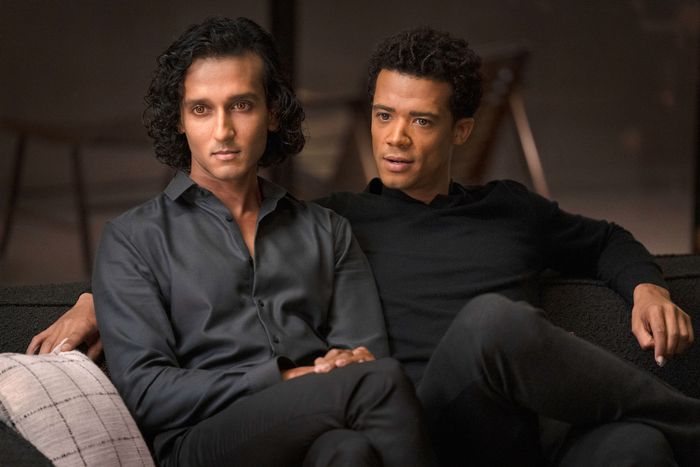
The age of “Peak TV” is over. We’re living in the rubble after the fall of the empire, in the damage it’s wrought, in a sulfuric landscape of pale imitators, mushroom monsters or nuclear zombies or whatever else I have no personal desire to ever watch, ruled over by Fury Road–style warlords like David Zaslav. We’re swimming in marital mysteries based on Strand-approved paperbacks, prestige comedies that don’t know how to be funny, dull Marvel nothings, and slick Netflix IP grabs. It sucks! And not in the pun-intended vampiric way I’m about to describe.
Popping up through the muck like a gorgeous swamp lily is AMC+’s horny-horror vampstravaganza Interview With the Vampire, which returned for its second season on May 12. This show slurps the marrow out of its many hours the way its vampires suck blood from their victims: sexily, dramatically, full of vim and deranged gusto. Based on the Anne Rice best seller and plié-ing out from behind the shadow of that book’s 1994 adaptation with Brad Pitt and Tom Cruise, Interview With the Vampire debuted in October 2022, which was ideal timing for its gothic spooky vibes. The premise: Aging truth-to-power badboy-journo Daniel Molloy (Eric Bogosian) interviews vampire Louis de Pointe du Lac (Jacob Anderson, brooding) about his immortal life, which began upon meeting sire-lover Lestat de Lioncourt (Sam Reid, chewing scenery so hard he’s fracturing his special-effects canines) in 1910s New Orleans. Decades of chaos ensue: swimming up rivers to spy on cheating lovers, domestic disputes that end in one partner launching the other into space, and at least one costume ball.
The first season wasn’t the biggest, most talked-about show on TV (maybe because it streams on AMC+), but it was undoubtedly the most most show on TV. Season two is only more-er, taking the story to the sordid playhouses of postwar Paris and looping in Armand (Assad Zaman) as Louis’s co-interviewee and, of course, lover. If vampire-human love quadrangles appeal to the dormant Twilight stan in you, or if you just want to see some good multi-hyphenate-genre TV, stop spending time on shows that aren’t trying this hard to entertain and let Interview With the Vampire seduce you. Here’s why you should watch it, even if you have to go to the great lengths of using AMC+.
It’s better than the book.
Okay, you might disagree. And I’ve only read part of the first book. Anne Rice did some incredible world-building in her Vampire Chronicles, but based on what I’ve read, this show has made exactly the right amount of changes to improve upon the story, balancing reverence for the books with a willingness to make substantial changes, and the result lets her characters shine and resonate in new ways. It’s an adaptation that seems to please book devotees (like Sam Reid, who’s obsessed) and newbies alike.
In the first book, Louis is a Louisiana plantation owner, and he and Lestat brutalize the enslaved people he owns, eventually killing them all to prevent an uprising. It’s southern Gothic, but Rice didn’t seem interested in going beyond shock value, which makes it difficult to lean in to the fun of the rest of the book. The show, on the other hand, makes the brilliant choice to anoint Louis the scion of a prominent Creole family, which introduces new themes, dynamics, and historical details into the story. Louis’s race gives the character much more dimension. As a human, he is in the awkward position of having access to New Orleans society’s halls of power while dealing with racism within those spaces. As a vampire, he has a unique lens on history as he lives through the decades. His identity makes his moral conflicts more pronounced and deepens his bond with Claudia (Bailey Bass in season one, Delainey Hayles in season two), particularly when the two are positioned against Lestat’s blond obliviousness. In this version, Claudia is orphaned when a racist mob burns down a neighborhood, and she’s aged up from being turned as a 5-year-old to something more like 13 or 14, which gives the character much more to do. And the most important change this adaptation made is …
It’s gay.
Vampires have always been gay, and they always will be gay. The 1994 Interview With the Vampire is one of the gayer movies of that decade, and it’s perverse and fascinating in the ways it doesn’t let its characters actually name or act upon their desires. This has merit in its own intense, closeted way, particularly when you read it as a product of its era, but the AMC+ show busts the whole saga wide open by actually letting the characters fall in love and fuck. Jacob Anderson and Sam Reid have truly unreal chemistry, as do Anderson and Zaman as his present-day lover and former coven leader Armand. Even during normal, shirts-on scenes, there’s a horny undercurrent that runs through the whole show as IWTV explores these characters’ dynamics in their relationships to each other: predator/prey, dom/sub, lover/ex, couple/third. This isn’t like other R-rated prestige TV shows where the sex scenes — when they even exist — feel perfunctory. They are not an afterthought or an addition. Romance, desire, abuse, jealousy, yearning … they’re the whole point! It’s a hot and very queer show!
It’s camp.
“Camp” gets tossed around a lot nowadays, often to (incorrectly) describe stuff that’s tacky and bad. Interview With the Vampire is “camp” in the true sense: in the Tiffany-lamps-and-gold-fringed-kimonos way, in the sense of ornamentation taken too far, in ecstatic bursts of genre horror à la midnight movies, in the emotional and aesthetic language of opera applied to a non-opera medium. Reid’s Lestat is a block-jawed Australian doing the poutiest French accent you’ve ever heard, enacting sadistic violence on the people of New Orleans with a skip, twirl, and upturned pinky until he decides to get dead serious and scary. Then there’s the production design: the French Quarter townhouse and its unhappy clutter, costumes inspired by by J.C. Leyendecker illustrations, goth makeup, ridiculous colored contact lenses to set the vamps apart, big group scenes at opera palaces and whorehouses. The occasional rips in the fabric — when a set or wig in an early episode looks cheap or a costuming decision feels off — only enhance the experience. They remind you this show is really just people having fun and trying shit. Wabi-sabi, baby.
It’s gory.
This show goes through gallons of corn syrup and red 40. That’s not unexpected, but all the ways the show figures out how to use it is. IWTV makes good on all the nasty people-eating terror Yellowjackets teased for an entire season, but piles on decapitations, mutilations, immolations, and too many shots of Jacob Anderson eating a rat. Toward the end of the pilot, Lestat punches a priest in the face and his fist comes out the back of his head, which will either turn you off the rest of the show or hook you immediately. Later in the season, Lestat prances into the luggage car of a train wearing a conductor’s hat, holding the conductor’s severed head, and puppeteering his mouth while playing a sick game of choo-choo. Very few vampire romances also count as legit horror; this is one of them.
It’s crawling with undead theater kids.
In season two, Louis and Claudia go to Europe to find more vampires like themselves and soon fall in with the centuries-old Paris coven. What Rice imagined, and what this show brings to life in brilliant fashion, is that the Paris coven takes the form of a goth vampire theater troupe co-founded by Lestat. The show introduces a whole new supporting cast of immortal theater kids, which is maybe the most horrific thing it’s done yet. They wear pancake makeup and eyeliner to accentuate their vampireness, they bicker, and they sleep together backstage after the shows. Their elaborate snuff plays are packed with German Expressionist–inspired aesthetics and stage tricks that make their real vampire abilities (flying) look fake (Elphaba-style wires and harnesses). The Théâtre des Vampires seduces audiences seeking thrills and fun and ends up implicating them in a show of human suffering. It’s everything Eddie Redmayne’s Cabaret wants to be, but it actually has teeth.
The writing, mon dieu, the writing. It’s so much.
And I mean that in the best way possible. The characters speak as if the scripts were written longhand in a giant, fluffy quill on parchment or anticipating their own fan fiction. Lestat, while discussing how he came around on the clunky English language, says, “I have English consonants to thank for this astonishing jawline.” It’s giving No one’s slick as Gaston, no one’s quick as Gaston. Or when Louis kills a racist white dude and says, “It was random and unfortunate that the man picked that night to dabble in fuckery.” Or lines pulled directly from Rice’s first book and delivered with a madman’s commitment, like, “You alone, of all creates, can see death with that impunity. You alone, under the rising moon, can strike like the hand of God!” It’s like nothing else on TV, except maybe Hannibal, if every character on Hannibal spoke like Hannibal. If you were to take a group of 400-year-old vampires, explain to them what a TV show was, and put them in a writers’ room, they would write a show that sounded like this.


